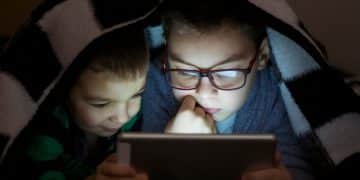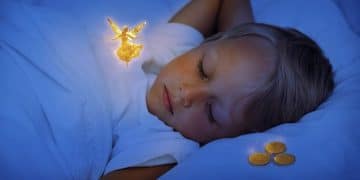Melatonin for Kids: Recent Findings on Safe Dosage

Recent findings suggest that while melatonin can be helpful for some children’s sleep issues, it’s crucial to understand the appropriate dosage and potential side effects to ensure safety and effectiveness.
Is your child taking melatonin to help with sleep? Recent findings: melatonin for kids – is the dosage you’re using safe? Understanding the latest research is vital for ensuring their well-being.
Understanding Melatonin and Its Role in Children’s Sleep
Melatonin is a hormone that naturally occurs in the body and helps regulate the sleep-wake cycle. It’s become a popular supplement for children struggling with sleep, but is it always safe? Let’s delve into the role of melatonin and its effects on children.
Many parents are curious about using melatonin to aid their children’s sleep. Understanding how melatonin works and its potential impact is essential before making a decision. It’s not a one-size-fits-all solution, and careful consideration is key.
How Melatonin Works
Melatonin is produced by the pineal gland in the brain. Its production is influenced by light exposure, typically increasing in the evening as darkness approaches, signaling the body to prepare for sleep.
Why Children Might Need Melatonin
Some children experience sleep difficulties due to various factors, including:
- Delayed Sleep Phase Syndrome: Difficulty falling asleep at a conventional bedtime.
- ADHD: Can interfere with sleep patterns.
- Autism Spectrum Disorder: Sleep disturbances are common in children with autism.
These conditions can disrupt a child’s natural melatonin production, leading to sleep problems. Supplemental melatonin is often considered to help regulate their sleep cycle.
In conclusion, melatonin plays a vital role in regulating sleep, but it’s not always a perfect solution for children’s sleep problems. Understanding the reasons behind sleep issues and consulting with a healthcare professional are essential steps before considering melatonin supplements.

Recent Studies: What the Science Says About Melatonin Dosage
Recent studies have shed light on the efficacy and safety of melatonin in children. While some studies support its use, others emphasize the need for caution and proper dosage. It’s important to stay informed about the latest research.
The scientific community continues to explore the benefits and risks of melatonin use in children. Parents need to be aware of the ongoing research to make informed decisions about their child’s health and well-being.
Efficacy of Melatonin for Sleep Issues
Studies have shown that melatonin can be effective in reducing sleep latency (the time it takes to fall asleep) in children with sleep disorders. However, the effects may vary depending on the child and the underlying cause of their sleep difficulties.
Safety Concerns and Potential Side Effects
While melatonin is generally considered safe for short-term use, potential side effects include:
- Drowsiness: Especially in the morning.
- Headaches: Some children may experience headaches as a side effect.
- Dizziness: Can occur in some individuals.
- Bedwetting: In rare cases, melatonin has been linked to bedwetting.
Long-term effects of melatonin use in children are not yet fully understood, highlighting the importance of cautious use. More research is needed to determine the long-term safety of melatonin supplementation in children.
In summary, the science surrounding melatonin dosage for children is evolving. While it can be effective for certain sleep issues, parents should be aware of potential side effects and exercise caution. Consulting with a pediatrician is crucial to ensure the safe and appropriate use of melatonin.
Determining the Right Dosage for Your Child
Figuring out the correct melatonin dosage for your child is crucial for both safety and effectiveness. The ideal dosage can vary depending on factors such as age, weight, and the specific sleep issue being addressed. It’s essential to approach this with care and professional guidance.
The right dosage is not just about milligrams; it’s about finding the balance that works for your child’s unique needs. Overdoing it can lead to unwanted side effects, while too little may not provide any benefit at all.

Consulting with a Pediatrician
Before giving your child melatonin, consult with a pediatrician or healthcare professional. They can assess your child’s specific situation and provide personalized recommendations based on their expertise.
General Dosage Guidelines
While a doctor’s advice is paramount, here are some general dosage guidelines:
- For younger children (under 6 years): Start with the lowest possible dose, such as 0.5 mg, and gradually increase if needed, under the guidance of a healthcare provider.
- For older children (6 years and older): A starting dose of 1 mg to 3 mg may be appropriate, but always consult with a pediatrician for specific recommendations.
Forms of Melatonin
- Tablets: Convenient for older children who can swallow pills.
- Liquid: Easier to administer to younger children.
- Gummies: Can be appealing to children, but be mindful of added sugars.
Liquid forms allow for precise dosing, which can be especially helpful when starting with a very low dose. It is important to read labels carefully and follow the pediatrician’s or healthcare provider’s exact instructions.
Achieving an ideal melatonin dosage for a child necessitates speaking to a trained healthcare professional who can assess individual needs. Always prioritize safety and adhere to expert advice to ensure your child’s well-being. The correct dosage is a personalized matter that shouldn’t be taken lightly.
Potential Risks and Side Effects of Melatonin in Children
While melatonin is generally considered safe, it’s essential to be aware of the potential risks and side effects associated with its use in children. Knowing what to watch out for can help you make informed decisions and ensure their well-being.
Just like any medication or supplement, melatonin is not without its potential downsides. Being informed about these risks allows you to monitor your child closely and take appropriate action if needed.
Common Side Effects
Some of the more common side effects of melatonin use in children include:
- Daytime Drowsiness: Child may feel sleepy during the day rather than at night.
- Headaches: Some children experience headaches as a side effect.
- Dizziness: Can cause a sense of imbalance or lightheadedness.
Less Common, but Serious Side Effects
Although rare, more serious side effects can occur:
- Increased Bedwetting: Can be concerning and should be discussed with a doctor.
- Changes in Mood or Behavior: Monitor for any unusual changes in mood or behavior.
Long-Term Effects
The long-term effects of melatonin use in children are not yet well-established. More research is needed to determine the potential impact on hormone development, puberty, and other aspects of health. Ongoing research is necessary to fully understand the long-term consequences of melatonin supplementation.
It’s important to maintain an open dialogue with your pediatrician about any concerns you may have regarding your child’s experience with melatonin, ensuring their overall health and well-being. Vigilance and communication will contribute to safe and effective management of their sleep issues.
Alternatives to Melatonin for Improving Children’s Sleep
Before resorting to melatonin, exploring alternative strategies for improving your child’s sleep is always a good idea. Natural methods and lifestyle adjustments can often be effective in addressing sleep issues without the need for supplements. Let’s look at other approaches worth considering.
Melatonin should not be the first resort, given that there may be other ways to improve your child’s sleep with no side effects. It is always wise to try these out before incorporating melatonin into your child’s bedtime routine.
Establishing a Consistent Bedtime Routine
A consistent bedtime routine can signal to your child’s body that it’s time to sleep. This could include:
- Warm Bath: Relaxing before bed.
- Reading a Book: A calming activity.
- Quiet Time: Avoiding screens before bed.
Creating a Sleep-Friendly Environment
Ensure the bedroom is conducive to sleep:
- Dark Room: Using blackout curtains.
- Quiet Room: Minimizing noise.
- Cool Temperature: Keeping the room at a comfortable temperature.
Behavioral Strategies
Consider strategies such as:
- Cognitive Behavioral Therapy (CBT): Helps address underlying sleep issues.
- Relaxation Techniques: Meditation and deep breathing exercises.
Always address the underlying causes of sleep issues instead of merely using melatonin as a quick fix. Consulting a health professional will enable one to identify factors that may be making it difficult for the child to fall or stay asleep. Ultimately, a holistic approach that combines sleep hygiene, behavior adjustments, and, whenever needed, proper guidance from professionals leads to better health.
Latest Recommendations from Pediatricians and Sleep Experts
Staying informed on the latest recommendations from pediatricians and sleep experts is critical for managing your child’s sleep effectively. Experts continually refine their advice based on new research and clinical experience. It’s good to remember the best approaches to make informed choices.
Pediatricians and sleep specialists are at the front of the study and management of child sleep disorders. Their recent insights and advice can often provide valuable insights for parents seeking sound practices.
When Melatonin Is Appropriate
Experts often recommend melatonin under specific circumstances:
- Certain Medical Conditions: Like ADHD or autism, where sleep difficulties are common.
- Short-Term Use: To help reset the sleep cycle after travel or illness.
Cautions and Considerations
Experts advise caution when:
- Long-Term Use: Emphasizing the need for ongoing monitoring.
- Underlying Issues: Addressing any underlying medical or psychological factors.
Importance of a Holistic Approach
Experts agree on the importance of a holistic approach that includes:
- Sleep Hygiene: Consistent routines and a sleep-friendly environment.
- Behavior Modifications: Addressing any behavioral factors that may be contributing to sleep problems.
To sum up, recommendations from pediatricians and sleep experts emphasize the targeted use of melatonin as well as the necessity of all-inclusive sleep habits and practices. Being current with their most recent advice does make positive differences that will ensure the health of the growing child and promote the achievement of good sleep habits.
| Key Point | Brief Description |
|---|---|
| 😴 Melatonin’s Role | Regulates sleep-wake cycle; consider for certain sleep issues. |
| 👩⚕️ Consult a Doctor | Essential before giving melatonin to children. |
| 🌱 Alternatives | Try sleep hygiene, routines first before melatonin. |
| ⚠️ Side Effects | Be aware of drowsiness, headaches, and rare issues. |
Frequently Asked Questions (FAQ)
item”>
▼
The long-term effects of melatonin use in children are not fully understood. More research is needed to determine its effects on hormone development and puberty. Consult with a pediatrician if you’re considering long-term use.
▼
Generally, a low dose such as 0.5 mg may be appropriate, but it’s best to consult with a pediatrician to determine the right dosage. They can assess your child’s specific needs and provide personalized advice.
▼
Melatonin can interact with certain medications, such as antidepressants and blood thinners. It’s important to inform your pediatrician about all the medications and supplements your child is taking to avoid any potential interactions.
▼
Melatonin typically starts working within 30 to 60 minutes after ingestion. It’s best to give it to your child about an hour before bedtime to help them fall asleep more easily and regulate their sleep cycle effectively.
▼
While supplemental melatonin is common, some foods contain melatonin, such as cherries, grapes, and tomatoes. Ensuring a dark sleep environment can also stimulate the production of melatonin naturally in your child’s body.
Conclusion
In conclusion, while recent findings: melatonin for kids – is the dosage you’re using safe? underscore the importance of cautious melatonin use for children, understanding the potential risks, benefits, and consulting with healthcare professionals ensures informed decisions. Prioritizing sleep hygiene and exploring alternatives can lead to healthier sleep habits for your child.





